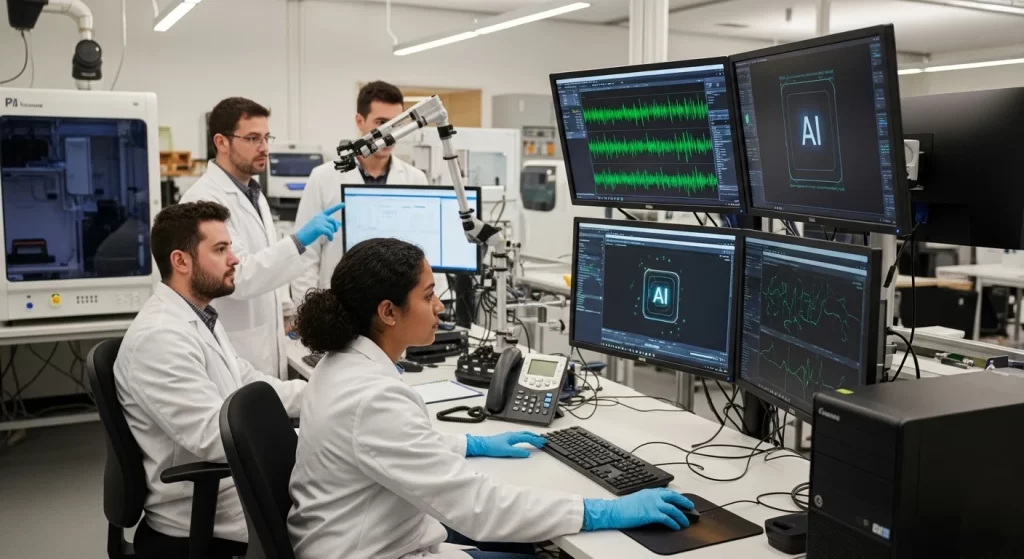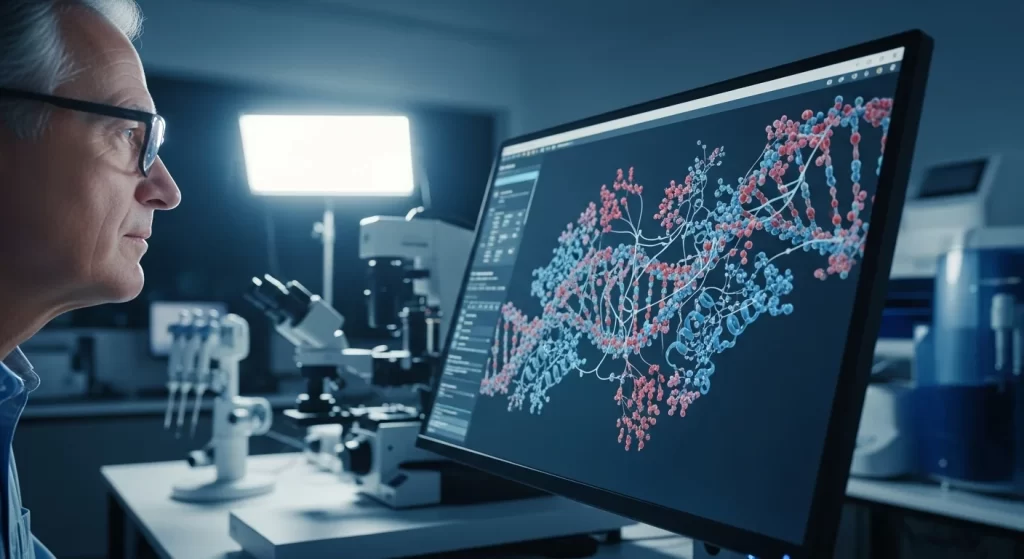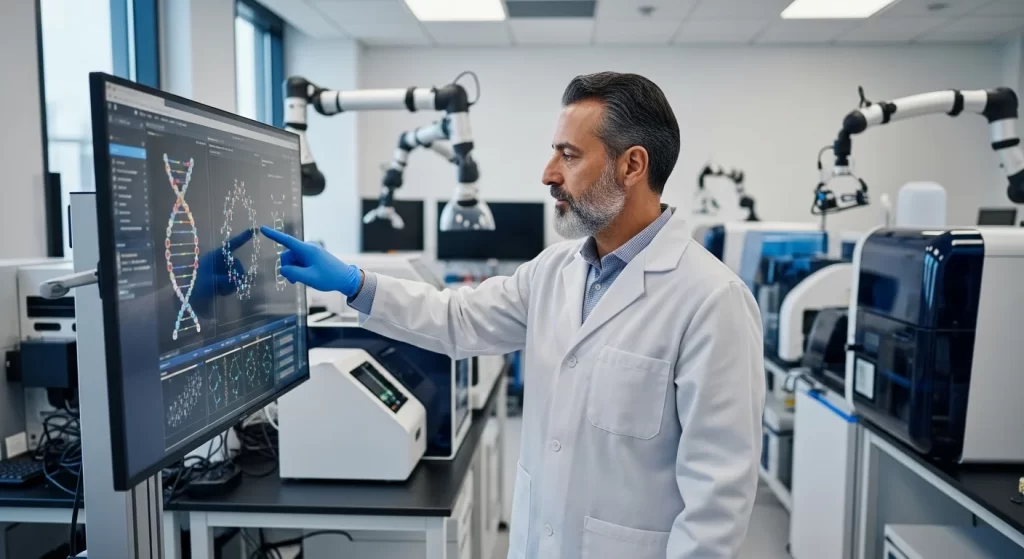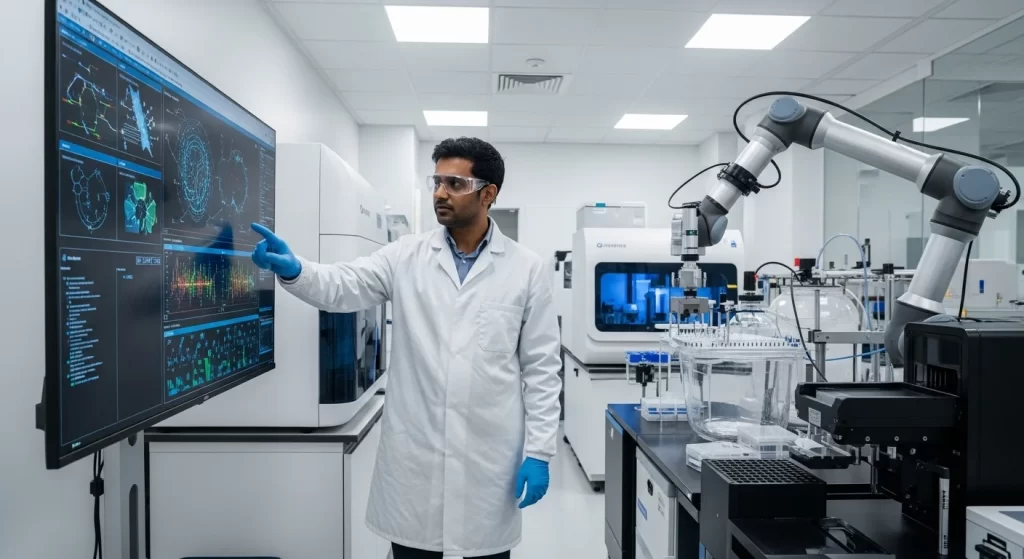The field of biology is grappling with an explosion of data, particularly from genomics. The sheer volume of genomic information, with each human genome containing billions of data points, presents an enormous analytical challenge that manual interpretation cannot overcome. Artificial Intelligence (AI) has emerged as an essential tool to unlock the insights hidden within this complex data. AI in genomics is pivotal for navigating this data deluge.

AI in genomics involves applying sophisticated computational methods, especially machine learning (ML) and deep learning (DL), to analyze and interpret massive datasets from genetic material like DNA, RNA, and proteins. The goals are to identify genes, understand their functions, predict disease likelihood, study genetic variations, and ultimately improve human health. It’s about simulating human intelligence in machines to tackle the complexities of our genetic makeup.
The journey into AI in genomics is complex but full of potential. SPsoft offers deep expertise in developing and integrating AI solutions to navigate this landscape!
The Convergence: A New Era of Personalized Healthcare
The fusion of AI and genomics marks a paradigm shift, heralding a new era for medical diagnostics and healthcare innovation. This synergy promises truly personalized healthcare, moving away from one-size-fits-all approaches to treatments tailored to an individual’s unique genetic blueprint. The vast amount of genomic data, once a challenge, now fuels AI’s advancement; more diverse data leads to more accurate AI models, creating a cycle of continuous improvement.
This integration signifies a transition from descriptive genomics to a predictive and prescriptive model. AI allows for the prediction of future health issues and the proactive prescription of interventions, fostering preventive healthcare. This evolution demands new interdisciplinary skills and robust ethical frameworks. This article explores how AI in genomics is revolutionizing healthcare, from personalized medicine and drug discovery to the burgeoning AI genomics market, also covering key innovations, challenges, and ethical considerations.
Understanding the Engine: How AI Deciphers Our Genetic Code
To grasp the transformative power of AI in genomics, it’s crucial to understand the core technologies and their application to genetic information.
AI in genomics uses advanced computational methods to analyze genetic data, simulating human intelligence to understand DNA, RNA, and proteins. This multidisciplinary field combines AI, genetics, data science, and biology to translate genomic insights into actionable knowledge for medical professionals.
Core AI Technologies Powering Genomic Discovery
Machine Learning and Deep Learning are central to AI genomics.
Machine Learning (ML): Uncovering Hidden Patterns
Machine Learning (ML) systems learn from data to identify patterns and make decisions without explicit programming for each task. In genomics, ML algorithms sift through vast datasets to discern subtle patterns, identify significant mutations, and classify genetic variants. Key applications of ML in genomics include:
- Identifying and interpreting genetic variants like SNPs.
- Analyzing gene expression from RNA-seq data to predict patterns and map networks.
- Deciphering noncoding regions to predict functional elements such as enhancers.
- Analyzing genomic sequences for classification and understanding evolutionary relationships.
- Predicting functions of uncharacterized genes.
- Identifying disease-associated variations in Genome-Wide Association Studies (GWAS).
- Classifying cancer types and predicting patient outcomes in cancer genomics.
- Predicting protein structures and functions, crucial for drug design.
- Analyzing microbial communities in metagenomics by identifying species and predicting gene functions.
Deep Learning (DL): Probing Deeper into Genomic Complexity
Deep Learning (DL), a more advanced ML branch, uses multi-layered neural networks to extract high-level features from data. DL excels with the high dimensionality and complexity of genomic data, often outperforming traditional ML in tasks like predicting gene expression or identifying regulatory elements. Key DL architectures and their roles in genomics include:
- Convolutional Neural Networks (CNNs). Suited for identifying spatial patterns in sequences (DNA/RNA), like transcription factor binding sites or splice sites. They automatically extract features, discovering meaningful patterns from input data.
- Recurrent Neural Networks (RNNs), including LSTMs and GRUs. Designed for sequential data (DNA, RNA, protein sequences), capturing long-range dependencies. Applications include protein function prediction and base calling.
- Transformers and Large Language Models (LLMs). Utilize attention mechanisms for long-range interactions in DNA sequences, promising in variant effect prediction and generating contextualized embeddings for molecular phenotype prediction.
- Autoencoders (AEs) and Variational Autoencoders (VAEs). Used for unsupervised tasks like feature extraction and dimensionality reduction of gene expression profiles, finding applications in drug response prediction.
This evolution towards specialized DL architectures signifies a maturation of the AI in genomics field, demanding expertise in both AI and biology.
How AI Analyzes Genomic Data
AI algorithms analyze genomic data by sifting through massive datasets to identify patterns, correlations, and anomalies often too complex for human detection. This analytical power translates into key capabilities, such as accelerating sequencing and reducing errors, swiftly identifying genetic variations linked to diseases, and crucially, integrating genomic data with other diverse data types like clinical records and lifestyle information for more holistic insights. This integration is vital for a nuanced understanding of disease and health, moving beyond genetic determinism.
Groundbreaking Applications of AI in Genomics
The capabilities of AI in genomics are rapidly translating into groundbreaking applications across biomedical research and healthcare.

Personalized Medicine and Precision Oncology: Treatments Tailored to Your DNA
Personalized medicine, tailoring treatment to individual patient characteristics, is powerfully enabled by AI genomics. AI analyzes a patient’s genomic data, clinical history, and lifestyle factors to predict disease risk, enable earlier diagnosis, and customize treatment strategies for optimal efficacy and minimal side effects.
AI excels at identifying disease-causing genes by sifting through millions of genetic variations to pinpoint those linked to specific conditions, crucial for diagnosing rare genetic disorders and understanding complex diseases. AI models predict the functional impact of these variations, allowing for earlier diagnoses.
Oncology is a flagship area for AI in genomics. Cancer is a genomic disease, and AI analyzes tumor genomes to identify driver mutations, enabling oncologists to select targeted therapies. This enhances efficacy and reduces side effects compared to traditional methods. AI-powered Clinical Decision Support Systems (CDSS) assist doctors by integrating patient genomic profiles, tumor characteristics, and medical history to recommend treatment plans. A USC-led study used AI to analyze genetic mutations in cancer patients, developing a tool to predict responses to immunotherapy in lung cancer.
Accelerating Drug Discovery and Development
The lengthy, expensive, and high-failure drug development process is being revolutionized by AI in genomics, making it faster, more cost-effective, and more successful. AI contributes to multiple stages:
- Target Identification & Validation. AI analyzes genomic and proteomic datasets to identify novel molecular targets and validate them by predicting the consequences of modulating their activity.
- Hit Identification & Lead Optimization. AI screens virtual libraries of compounds to find “hits” and optimizes them into “lead” compounds by predicting interactions and designing novel candidates.
- Preclinical Research. AI helps design informative preclinical studies and predict potential toxicities.
- Clinical Trial Optimization. AI improves clinical trial design by identifying patient populations likely to respond to a new drug based on their genomic profiles.
- Drug Repurposing. AI analyzes data to identify existing drugs for new diseases, shortening development timelines.
Enhancing Genome Sequencing and Analysis
AI in genomics significantly enhances DNA sequencing. AI algorithms accelerate the interpretation of Whole-Genome Sequencing (WGS) results, reducing time and cost while improving accuracy by flagging errors. AI tools rapidly identify genetic variants, crucial for diagnosing conditions and assessing risk. AI, particularly deep learning, also automates gene annotation and the interpretation of variants of unknown significance, freeing human experts for more complex questions.
Advancing Gene Editing: The CRISPR-AI Synergy
Gene editing technologies like CRISPR-Cas9 hold immense promise for treating genetic diseases. The synergy between AI and genomics makes these tools more precise, efficient, and affordable. AI’s role in improving CRISPR tech is multifaceted:
- gRNA Design and Efficiency Prediction. AI models design optimal guide RNAs (gRNAs) and predict their on-target cutting efficiency with high accuracy.
- Off-Target Effect Minimization. AI algorithms predict potential off-target sites with greater accuracy, allowing researchers to minimize unintended edits.
- Advancing Base Editing (BED) and Prime Editing (PED). AI models predict the outcomes and efficiencies of these sophisticated editing techniques, refining their application.
Generative AI tools can also contribute by predicting protein form and function, relevant for designing or improving Cas enzymes.
Biomarker Discovery: Finding New Clues for Disease
AI and genomics are exceptionally powerful for discovering novel biomarkers — measurable indicators of biological states, such as genetic mutations or protein signatures — associated with diseases. These are critical for new diagnostic tests, predicting prognosis, monitoring treatment, and stratifying patients. AI algorithms analyze patient genomic data to identify molecular signatures correlated with conditions like cancer or Alzheimer’s.
Population-Scale Genomics: Insights from Big Data
Sequencing genomes from large, diverse populations, combined with AI’s analytical power, yields unprecedented insights into human health and disease at a population level. This helps understand population-level genetic variations, identify genetic factors for diseases, map human migration, and study evolutionary genetics.
The Booming AI Genomics Market: Trends and Opportunities
The convergence of AI and genomics fuels a rapidly expanding global market, characterized by explosive growth and significant investment. The AI genomics market reflects the immense value and transformative potential of these technologies.

Market Size and Explosive Growth
The AI in genomics market is on a steep upward trajectory. Market.us valued the global market at approximately USD 733.4 Million in 2023, projecting it to reach USD 35.267 Billion by 2033, with a CAGR of 47.3%. ResearchAndMarkets.com estimated it at USD 1.15 billion in 2023, forecasting USD 13.65 billion by 2029, with a CAGR of 51.03%. This rapid expansion indicates increasing investment and adoption of AI and genomics technologies. This high CAGR reflects pressing societal needs for effective treatments, maturation of technologies, and investor confidence.
Key Market Segments Driving Growth
The AI genomics market can be segmented, highlighting different growth facets:
- By Component. Software (dominant, fastest CAGR), Hardware, and Services. The primary value lies in intelligent software systems.
- By Technology. Machine Learning (commanded the market), Deep Learning, and Computer Vision.
- By Functionality. Genome Sequencing (largest market share), Gene Editing, and Other Functionalities. AI accelerates and improves sequencing.
- By Application. Drug Discovery & Development (market leader), Precision Medicine, and Diagnostics. AI’s potential to reduce drug development time and cost is a major driver.
- By End-User. Pharmaceutical and Biotech Companies (largest market share), Healthcare Providers, and Research Centers/Academic Institutions.
Driving Factors for the AI Genomics Market
Several key factors propel the AI genomics market:
- Massive Data Generation. The explosion in genomic data necessitates AI for effective analysis.
- Demand for Cost-Effective Solutions. AI offers more efficient and cost-effective approaches to genomic analysis and drug development.
- Growing Demand for Personalized Medicine. Increasing demand from patients and clinicians for tailored treatments fuels the market.
- Continuous Technological Advancements. Ongoing improvements in AI algorithms and sequencing technologies expand capabilities.
- Increased R&D Investment and Funding. Significant financial investment flows into AI genomics research from public and private sources.
Major Players and Competitive Landscape
The AI genomics market includes technology giants, specialized bioinformatics companies, and innovative startups like IBM, Microsoft, NVIDIA, Deep Genomics, Illumina, and SOPHiA GENETICS. The market is competitive, with strategic partnerships, like Microsoft and Genoox. This environment will likely lead to accelerated innovation and potential consolidation.
Emerging Trends in the AI Genomics Market
Emerging trends shaping the AI genomics market include:
- The increased use of deep learning for base calling in sequencing
- The growth of foundation models and GenAI in research and drug discovery
- A greater focus on integrating multi-omics data
- The rising importance of ethical considerations and data privacy
- The expansion of applications beyond healthcare into areas like agriculture
- The continued market dominance of North America
Pioneering the Future: Innovations Shaping AI in Genomics
AI in genomics is a hotbed of innovation, constantly pushing boundaries.

Generative AI: Designing Biology Anew
Generative AI (GenAI) is a particularly exciting frontier. Unlike AI models that analyze existing data, GenAI can create entirely new synthetic DNA, RNA, or protein sequences with desired properties. This marks a shift from analysis to creation, leading to Generative Genomics, a field aiming to make biology a predictive and engineering discipline. Applications include designing novel proteins for drugs or enzymes, optimizing gene sequences for expression, and predicting cellular responses. Stanford’s Evo 2, for example, can predict protein form and function and generate new genetic sequences, potentially distinguishing harmful mutations from benign ones. MIT’s ChromoGen uses generative AI to rapidly calculate 3D genome structures, vital for understanding gene regulation.
Advanced AI Platforms: Integrating and Scaling Genomic Insights
There’s a trend towards sophisticated AI platforms that integrate massive datasets, optimized data processing, advanced ML systems (including foundation models and LLMs), and robust software engineering. Deep Genomics’ BigRNA platform is an RNA foundation model for discovering novel disease mechanisms and identifying therapeutic candidates, predicting RNA expression at sub-gene resolution.
AI in Multi-Omics Research: A Holistic View of Biology
Modern research is increasingly ‘multi-omic,’ integrating genomic data with transcriptomic, proteomic, epigenomic, and metabolomic data. AI in genomics is indispensable for analyzing these complex datasets, identifying subtle patterns and causal links between biological layers for a more complete picture of cellular function and disease.
Explainable AI (XAI) and Interpretable Machine Learning (IML): Opening the Black Box
The development of Explainable AI (XAI) and Interpretable Machine Learning (IML) is critical for the responsible deployment of AI in genomics. Many advanced AI models operate as “black boxes,” their decision-making processes opaque. This hinders clinical adoption and trust. XAI/IML techniques make AI models more transparent and understandable. In genomics, XAI is crucial for validating that AI models learn biologically relevant patterns, identifying potential biases, discovering novel biological insights from model-important features, and gaining regulatory approval and clinical acceptance.
Challenges and Ethical Frontiers of AI in Genomics
Despite its immense promise, AI in genomics faces significant hurdles.

Technical and Data Challenges in AI Genomics
Genomic data’s complexity, high dimensionality, and potential for noise demand sophisticated algorithms. High-quality, accurately labeled training datasets are essential but often scarce, leading to models with poor generalizability. The “black box” nature of many AI models necessitates Explainable AI (XAI) to build trust and facilitate validation. Training complex AI models requires substantial computational resources and specialized expertise, creating barriers for smaller institutions. Genomic datasets also frequently suffer from class imbalance and confounding factors, which can bias models if not carefully addressed.
Ethical, Legal, and Social Implications (ELSI) of AI in Genomics
The convergence of AI and genomics raises complex ethical, legal, and social issues. Key concerns include:
- Data Privacy and Security. Genomic data is highly personal. Protecting it from unauthorized access and misuse is paramount. Regulatory bodies like the NIH have issued guidelines for protecting human genomic data when developing generative AI models.
- Algorithmic Bias, Fairness, and Equity. AI models can inherit and amplify biases from unrepresentative training data, leading to health disparities. Ensuring fairness and equitable benefit distribution is critical.
- Informed Consent. Traditional consent models may be inadequate for AI research using large, aggregated datasets. Ensuring individuals understand how their genomic data will be used by AI is a challenge.
- Accountability and Responsibility. Determining accountability when AI systems err and cause harm is complex. Clear governance mechanisms are needed.
- Over-reliance and Automation Bias. Clinicians might over-rely on AI predictions, accepting them without critical scrutiny.
- Public Trust and Engagement. Public trust depends on transparency, ethical oversight, demonstrable benefits, and meaningful public engagement.
The field must grapple with questions about genomic data ownership, equitable benefit distribution, standards for AI tool deployment, balancing benefits with privacy, societal implications of disease predisposition predictions, and governing generative AI for modifying genetic sequences.
Regulatory Landscape
The rapid pace of AI in genomics challenges traditional regulatory pathways. Adaptive regulatory frameworks are needed to ensure safety, efficacy, and ethical use. International consensus guidelines like FUTURE-AI are emerging to provide best practices. Foundational ethical frameworks like UNESCO’s Universal Declaration on the Human Genome and Human Rights also guide development.
The Horizon Ahead: The Evolving Future of AI in Genomics
AI in genomics is characterized by rapid evolution and immense future potential. Predictions for the next 5-10 years include the mainstreaming of AI-powered genomic drug development and personalized medicine beyond oncology, maturation of generative AI for de novo design of therapies and sequences, standardization of multi-omics integration using AI, enhanced diagnostic capabilities for a broader array of diseases, advancements in AI-assisted gene editing making therapies more applicable, and profound insights from AI analysis of population-scale genomic initiatives.

Democratization of Genomic Medicine
AI could democratize access to sophisticated genomic analysis and personalized medicine, especially in resource-limited settings. AI-powered diagnostic tools could be deployed more widely, assisting healthcare professionals. However, this requires addressing the digital divide and ensuring equitable access to AI techs and data.
Continued Advancements in AI Algorithms and Computational Power
AI algorithms and computational power will continue to advance, improving accuracy, efficiency, and interpretability. Bio-AI, algorithms designed for biological data, will likely accelerate. Quantum computing, though nascent, could eventually provide unprecedented computational capabilities.
Enhanced Predictive Capabilities and Proactive Healthcare
AI in genomics points towards a more predictive and proactive healthcare system. AI models analyzing genomic and health data will better predict disease risk and drug responses, empowering personalized preventive strategies. This shift may evolve definitions of health and disease, leading to a probabilistic understanding managed with AI-generated genomic insights.
Conclusion
The convergence of artificial intelligence and genomics is reshaping our understanding of life and revolutionizing medicine. AI in genomics offers transformative potential in personalized treatments, drug discovery, and diagnostics.
Harnessing this potential requires a dual commitment: fostering bold innovation while proactively addressing complex ethical, legal, and social challenges. Data privacy, algorithmic bias, equity, consent, and accountability must guide development. Progress depends on collaboration among researchers, clinicians, AI developers, ethicists, policymakers, and an engaged public.
The vision is an AI-powered genomics future enabling healthcare that is more predictive, preventive, personalized, and participatory. While the journey is complex, the promise of AI in genomics to improve human well-being is a powerful motivator for responsible stewardship. Success hinges on societal acceptance and trust, cultivated through transparency, ethical conduct, and demonstrable benefits for all.
The future of healthcare depends on the language of AI and genomics. SPsoft has the advanced expertise in creating and integrating sophisticated AI tools!
FAQ
What exactly is AI in genomics, and why is it such a game-changer for medicine?
AI in genomics refers to using artificial intelligence, especially machine learning and deep learning, to analyze and interpret vast amounts of genetic data (like DNA and RNA). It’s a game-changer because the human genome is incredibly complex; AI can identify patterns, predict disease risks, and help develop new treatments much faster and more accurately than humans alone, leading to breakthroughs in personalized medicine.
How is AI making personalized medicine a reality today, especially in cancer treatment?
AI analyzes a patient’s unique genetic makeup, tumor mutations, and other health data to help doctors choose the most effective treatments, particularly in cancer. For example, AI and genomics can identify specific genetic markers in a tumor that indicate whether it will respond better to a targeted therapy or immunotherapy, avoiding ineffective treatments and improving patient outcomes.
Can AI really speed up the discovery of new drugs using our genes? How does that work?
Yes, AI in genomics significantly accelerates drug discovery. AI algorithms can analyze genomic data to identify new potential drug targets (genes or proteins involved in disease), predict how different drug compounds might interact with these targets, and even help design novel therapeutic molecules. This reduces the time and cost of traditional trial-and-error approaches.
What are the real ethical dilemmas we face with AI analyzing our genetic data?
Key ethical dilemmas include ensuring the privacy and security of highly sensitive genetic data, preventing algorithmic bias where AI tools might be less accurate for certain population groups, obtaining truly informed consent for data use, and determining accountability when AI systems make errors. There are also concerns about potential genetic discrimination.
Are they a super-powered duo for fixing genetic diseases?
They are indeed a powerful combination. CRISPR is a gene-editing tool, and AI enhances its precision and efficiency. AI in genomics helps design the best guide RNAs for CRISPR to target specific genes accurately, predicts potential off-target effects to minimize risks, and can even help optimize newer editing techniques like base and prime editing. This synergy accelerates the development of gene therapies.
How “smart” can AI get in predicting my risk for genetic disorders based on my DNA?
AI is becoming increasingly sophisticated at predicting genetic disorder risk. By analyzing an individual’s DNA sequence and comparing it to large population datasets and known disease-variant associations, AI genomics models can estimate predispositions to various conditions, from single-gene disorders to complex diseases like heart disease or diabetes. However, these are predictions of risk, not certainties, and environmental factors also play a role.
What’s the next big thing for AI in huge human genome studies, like those involving millions of people?
In large-scale population genomics, AI will enable deeper insights into how genetic variations contribute to health and disease across diverse populations. Future trends include using AI and genomics to understand complex gene-environment interactions, identify genetic markers for drug response variability, and uncover the genetic basis of polygenic (many-gene) traits more effectively. This will be crucial for developing equitable healthcare solutions.
Can AI find hidden clues (biomarkers) in our DNA that point to early signs of disease?
Yes, biomarker discovery is a key application of AI in genomics. AI algorithms can sift through genomic, transcriptomic (RNA), and proteomic (protein) data to identify subtle molecular signatures or patterns (biomarkers) that are associated with the early stages of diseases, often before clinical symptoms appear. These biomarkers are vital for developing new diagnostic tests and for early intervention.
Is the AI genomics market just for big pharma, or can smaller research labs and hospitals benefit too?
While large pharmaceutical companies are major players in the AI genomics market, the technology is becoming more accessible. Cloud computing provides access to computational power, and open-source AI tools are available. Smaller research labs and hospitals can benefit from AI for tasks like data analysis, diagnostic support, and participating in collaborative research, though resource disparities remain a challenge.
How does AI help doctors choose the right medical treatment based on my unique genetic profile?
AI-powered clinical decision support systems (CDSS) integrate a patient’s genetic profile with their clinical data, medical history, and sometimes even information from similar patients. The AI and genomics algorithms then analyze this comprehensive data to predict which treatments are most likely to be effective and least likely to cause adverse effects for that specific individual, helping doctors make more informed, personalized therapeutic choices.



